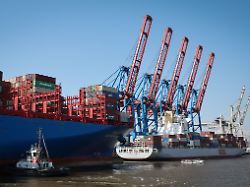Forecast slightly raised
Global economy prepares for “soft landing”
11.06.2024, 16:38
In January, the World Bank painted a gloomy picture of the global economy. A new forecast looks somewhat more optimistically into the future. Growth of 2.6 percent is expected. At the same time, the situation for many developing countries remains bleak.
According to a forecast by the World Bank, the global economy is stabilizing for the first time in three years, despite geopolitical tensions and high interest rates – albeit at a low level. As in the previous year, the global economy will grow by 2.6 percent this year, the World Bank announced in Washington. It thus slightly raised its forecast for 2024 compared to January (plus 0.2 percentage points).
The fact that the global economy is stabilizing faster than expected and inflation is falling is a good sign, said chief economist Indermit Gill. Less positive, however, is that average growth in the forecast period is around half a percentage point lower than in the decade before the coronavirus pandemic. Another bad news is that the world’s poorest countries continue to be in a particularly bad economic situation.
The World Bank predicts economic growth of 2.7 percent for 2025 and 2026. The global economy appears to be finally preparing for a so-called soft landing, the report says. This means less inflation without a recession and high unemployment. But more than four years after the start of the pandemic and the subsequent global shocks, it is clear that the world – and developing countries in particular – have not yet found a reliable path to prosperity, warns the World Bank.
USA is a “remarkable ray of hope”
“Things are not looking good for the smallest and poorest economies in terms of either stability or growth,” says chief economist Gill. They are suffering from high levels of debt and climate disasters. The World Bank warns that by the end of this year, one in four developing countries will be poorer than on the eve of the pandemic. By 2026, the countries in which more than 80 percent of the world’s population live will still grow more slowly on average than in the ten years before the coronavirus pandemic, according to forecasts. The World Bank assumes that many developing countries will not catch up with the industrialized nations in the near future.
The situation is different in the USA. According to the World Bank, the economic development in the world’s largest economy is a “remarkable bright spot”. The US economy has shown impressive resilience. “Growth has remained strong despite the harshest monetary tightening in four decades,” says the World Bank. The dynamism in the USA is one reason why the global economy has some upward potential in the next two years.
The World Bank draws a mixed conclusion for Europe. After growth in the euro area slowed significantly in 2023, the World Bank is forecasting growth of 0.7 percent for 2024 (January: 0.7 percent) and 1.4 percent for the coming year (January: 1.6 percent). Growth appears to have bottomed out, albeit with significant differences between individual sectors and member states, the report says. The services sector is indicating an incipient improvement. However, this is being offset by a weaker-than-expected industrial economy – particularly in the manufacturing sector in Germany.
World Bank looks with concern to the Middle East and Ukraine
Because of Russia’s war of aggression against Ukraine, the West imposed far-reaching sanctions on Russia – but the economy there proved resilient. According to the World Bank, this was due to the ramped-up war economy, subsidies and private demand, which was stronger than expected. The World Bank forecasts economic growth of 2.9 percent for 2024 (January: 1.3 percent), and 1.4 percent (January: 0.9 percent) for next year. Military production continues to have positive effects, but private demand is likely to decline. The World Bank emphasizes that Russia’s trade relations with China in particular have grown.
The World Bank is concerned about the Middle East and Ukraine. Conflict-related disruptions to oil supplies from the Middle East could lead to significant increases in oil prices, the report warns. In the worst case scenario, this could stall progress in the fight against high inflation. Russia’s war of aggression in Ukraine also poses uncertainty for the commodity markets – particularly with regard to oil and grain. According to the forecast, global inflation is expected to average 3.5 percent this year and 2.9 percent next year. This is a slower slowdown than expected.
The World Bank assumes that central banks will remain cautious about easing monetary policy in view of the ongoing inflationary pressure. The experts estimate that the average key interest rates in the coming years will be about twice as high as the average for the years 2000 to 2019. Most recently, the European Central Bank (ECB) cut interest rates by 0.25 percentage points. On Wednesday, the US Federal Reserve will decide on its future monetary policy. Observers assume that the Fed will leave the key interest rate at a high level.
